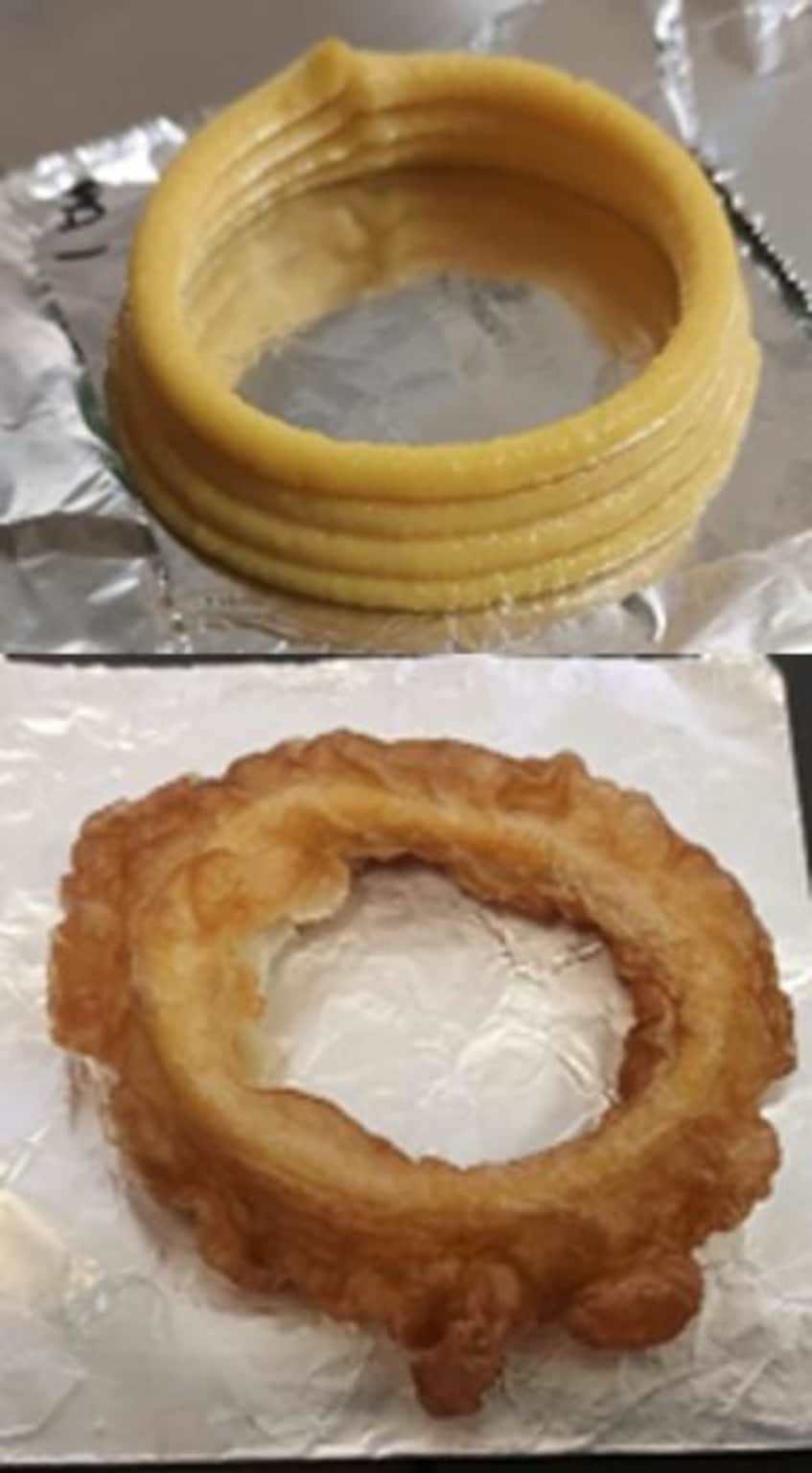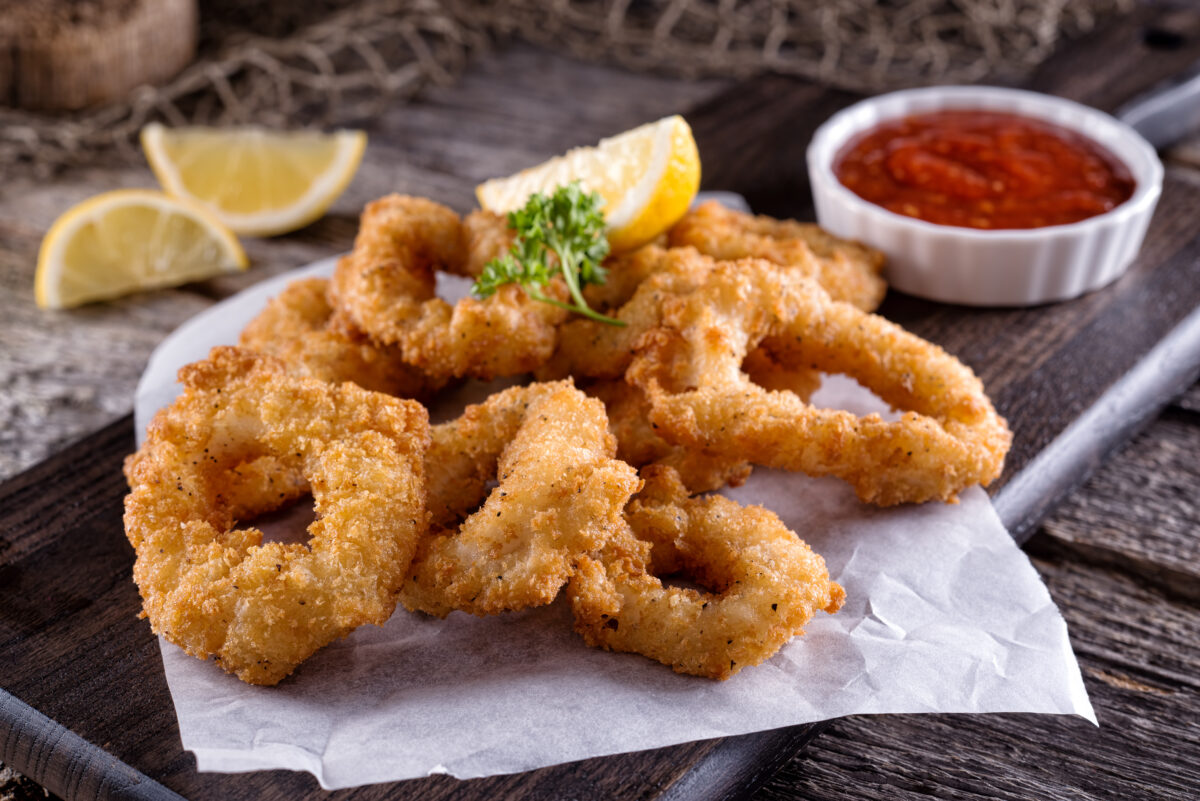
(Photo by WIROJE PATHI on Shutterstock)
In a nutshell
- Scientists successfully 3D printed plant-based calamari rings using mung bean protein and microalgae, creating a seafood alternative that closely matches real squid in texture and even surpasses it in protein content.
- The 10% microalgae formulation achieved the best results, producing calamari mimics that were softer, springier, and structurally similar to real calamari, without relying on overfished marine resources.
- This innovation highlights a promising future for sustainable seafood alternatives, leveraging underused crops like mung beans and algae to reduce pressure on ocean ecosystems while meeting growing demand for plant-based foods.
SINGAPORE — Your next fried calamari appetizer might come from a printer, not the ocean. Scientists from the National University of Singapore have successfully 3D printed plant-based calamari rings that closely mimic both the texture and protein content of real squid.
The research, published in ACS Food Science & Technology, involved combining two sustainable protein sources that are currently underutilized: mung beans (small green legumes popular across Asia) and microalgae. The result? A convincing calamari alternative that could help address growing concerns about overfishing, marine pollution, and seafood contamination.
With the global vegan food market expected to more than double from $16.55 billion in 2022 to $37.45 billion by 2030, plant-based seafood remains an untapped opportunity. Currently, seafood alternatives make up less than 1% of the plant-based food sector.
The research team created what they call a “composite ink” by combining protein extracted from mung beans with bead-milled microalgae biomass. This mixture was then loaded into a 3D printer that precisely shaped the material into realistic calamari rings.

To achieve the proper texture, researchers experimented with various concentrations of gellan gum (a food-grade thickening agent), fat content, and microalgae amounts. After extensive testing, they determined that the optimal formula contained 1.5% gellan gum, 2% fat, and 10% microalgae biomass.
The team conducted detailed rheological analyses, tests that measure how materials flow and deform, to ensure their plant-based mixture would move smoothly through the 3D printer nozzle and maintain its shape afterward. They needed an ink with “shear-thinning behavior,” meaning it flows more easily under pressure (like when being squeezed through a printer nozzle) but firms up once that pressure is removed.
How the Fake Calamari Stacks Up
The 3D-printed rings were then battered and deep-fried, just like conventional calamari. When compared to real squid rings in texture tests, the version containing 10% microalgae most closely matched authentic calamari in terms of hardness, springiness, and cohesiveness.
The plant-based alternative actually contained more protein than the real thing. The printed calamari with 10% microalgae delivered 19.61% protein content, compared to 14.21% in actual squid rings.
Ocean Conservation
Environmental concerns about traditional seafood sources are currently mounting. Beyond overfishing and marine biodiversity loss, seafood consumers increasingly worry about contaminants like microplastics and heavy metals.

Mung beans are widely cultivated across Asia, with processing byproducts often going to waste. Thailand’s mung bean starch industries alone produce approximately 600 tonnes (about 1.3 million pounds) of high-protein wastewater daily. Meanwhile, microalgae can be grown on non-arable land with minimal freshwater requirements compared to both animal and plant proteins.
A study of Singaporean consumers found microalgae-based foods were positively perceived, especially among younger, health-conscious individuals attracted to products labeled as “innovative” and “environmentally friendly.”
There is also a lack of calamari alternatives out there. Researchers found only four substitutes (three vegan, one vegetarian) compared to 140 traditional squid products between 2002 and 2021.
The research team noted that higher concentrations of microalgae (20% versus 10%) actually compromised the structural stability of the calamari rings, particularly during frying. This suggests there are still technical hurdles to overcome before such products reach commercial viability.
3D printing technology, combined with sustainable protein sources, can create customizable, nutritious seafood alternatives that closely resemble the real thing, not just in appearance but also in protein content and mouthfeel. As seafood supplies face increasing pressure from environmental factors, innovations like this could help reduce impacts on marine ecosystems at a time when seafood supplies are in danger of dwindling.
Paper Summary
Methodology
Researchers extracted protein isolate from mung beans by creating a 20% water dispersion, adjusting pH to 8, then precipitating proteins at pH 4.5 before neutralizing to pH 7. They prepared microalgae by bead-milling with ethanol and drying. The composite ink combined these ingredients with varying levels of gellan gum (0.5-2%), fat (1-4%), and microalgae (0-20%). The mixture underwent blending, sonication, heating at 90°C, cooling, and overnight incubation at 4°C before final blending. Researchers analyzed the ink’s rheological properties using a rotational stress-controlled rheometer, conducting several tests including three interval-time thixotropy testing, yield stress determination, and frequency sweep analysis. They 3D printed the calamari rings using a Foodini printer with a 4000 μm nozzle, creating four-layer rings that were frozen, battered, and deep-fried at 180°C for 30 seconds. Texture analysis compared the plant-based mimics to real calamari using compression testing, while confocal laser scanning microscopy examined microstructure.
Results
The optimal formulation contained 1.5% gellan gum, 2% fat, and 10% microalgae biomass, which provided the best combination of printability, structure stability, and texture. The 10% microalgae formulation achieved a protein concentration of 19.61%, exceeding real calamari’s 14.21%. Texture analysis showed that 10% microalgae samples (192.83g hardness) more closely matched real calamari (180.85g hardness) than control samples without microalgae (311.09g hardness). Microscopy revealed that microalgae created a more discontinuous protein matrix with voids that mimicked calamari’s softness and elasticity. The calamari mimic maintained thermal stability during frying, with minimal differences in thermal transitions between formulations.
Limitations
Higher concentrations of microalgae (20%) compromised structural stability during frying. The commercial microalgae biomass used had undergone spray-drying, which caused protein denaturation and reduced solubility (1.14% compared to mung bean protein’s 85.6% solubility). This made the microalgae function more as a filler than a fully functional protein. The research did not assess flavor profiles or conduct consumer acceptance testing, which would be necessary before commercial application.
Funding/Disclosures
The research was supported by the National Research Foundation (NRF2020-THE003-0004), Prime Minister’s Office, Singapore under its Campus for Research Excellence and Technological Enterprise (CREATE) programme. One author acknowledged support from the Commonwealth Research Scholarship. The authors declared no competing financial interests.
Publication Information
The study, titled “3D Printing for Seafood Mimic: Factors Impacting the Rheology and Texture of Microalgae and Mung Bean Protein Composite ink,” was published in ACS Food Science & Technology on March 22, 2025. The authors were Poornima Vijayan, Zhixuan Song, Melody Ru Yee Yap, Dingsong Lin, and Dejian Huang from the Department of Food Science & Technology at the National University of Singapore and the National University of Singapore (Suzhou) Research Institute.








No. you created Bean Rings… NOT Calimari.
Just as calling a Man a Women doesn’t make him female calling something made out beans calimari doesn’t make it so.